
E2015_Rules_EU_EN_final
.pdf
EUROBOT
Page 21
… Rules… Rules… Rules… Rules… Rules… Rules… Rules… Rules… Rules… Rules…
combustion or pyrotechnic processes are prohibited for safety reasons. Any corrosive products or other liquids that can splash are not allowed for the same reason. It is also prohibited to use living beings inside the robot.
If you have any doubts about an unusual energy source, please ask the referees in time.
To prevent the risk of fire, special attention should be paid to the choice of conductors, depending on the intensity of current passing through them. It is also recommended to protect the wiring with a fuse that should be placed as close to the batteries as possible.
Beware! Power supply systems must be easily transportable. Teams may have to walk up/walk down stairs to access the stage where the matches take place.
Only electric energy can transmitted to the robot. The maximal voltage allowed is 13.8V (measured between two wires of the cable and of the robot). The organizers do not provide this energy source during the event. Teams will have access to the standard 230V, 50Hz. In case of using batteries, these ones should be waterproof. The terminals must be insulated.
Batteries
Both robots must be able to play at least three matches consecutively. Please note that this also includes the time during the preparation phase before the match itself. During this phase the robots have to stand by waiting for the start signal. For details on the procedures of a match please take a look at chapter Erreur ! Source du renvoi introuvable..
Therefore, it is strongly recommended to have several sets of batteries with the possibility to change them easily without too much effort. It is also very advisable to keep a set of batteries fully charged at any time.
Special note for batteries based on Lithium:
These types of batteries are permitted only under strict conditions:
A charger suitable for the batteries in use must be presented during the approval.
The batteries must remain inside certified and unaltered safety bags at any time. (This includes also the time when they are not in use or being recharged)
A system to detect and prevent undervoltage is strongly advised.
Those restrictions do not apply if the batteries are inside commercial products such as laptops, mobile phones or LEGO NXT and only if they are not altered or modified in any way.
4.Design constraints and mandatory equipment
i............ Common part
a. Visibility
The organizers of the event may want to place stickers containing the team number and sponsors on your robots. Two rectangular areas of 100x70 mm have to be provided for this purpose on each robot. The team can choose the position of the areas as long as they are on two different sides of the robot.
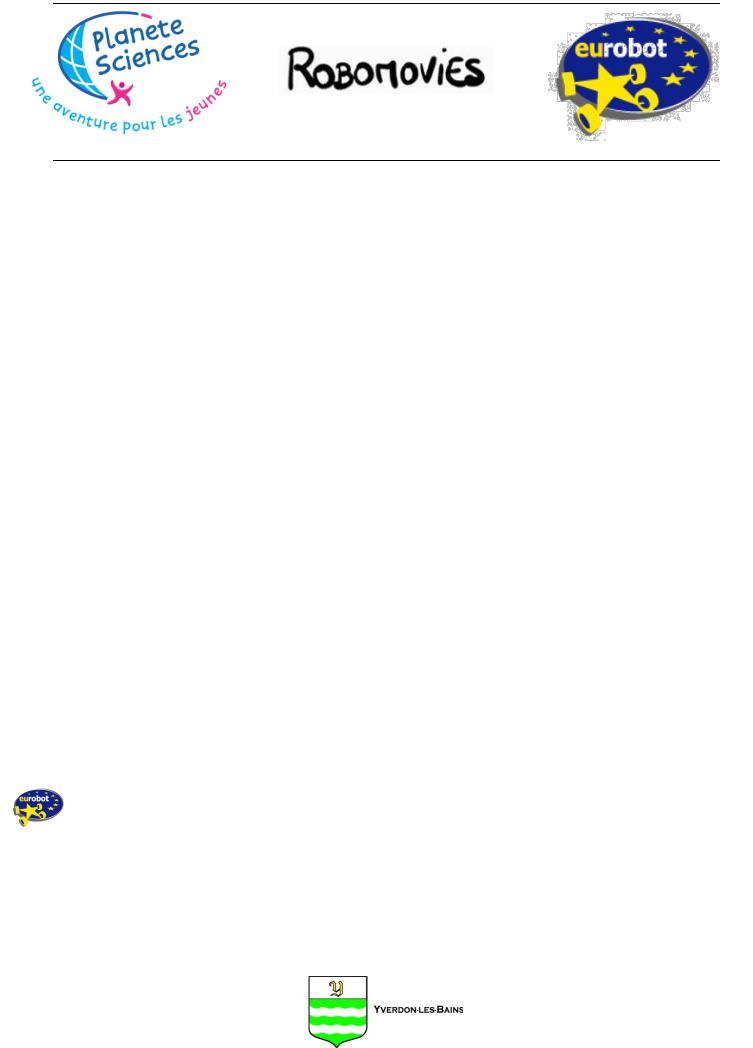
EUROBOT
Page 22
… Rules… Rules… Rules… Rules… Rules… Rules… Rules… Rules… Rules… Rules…
The teams are strongly encouraged to make the mechanism inside the robot visible to the audience and other participants. It is in the spirit of education and knowledge-transfer to understand how the robots function.
b. Starting cord of autonomous robots
At the beginning of a match the robots must be started with a so called starting device. This device has to be triggered by pulling a cord with a length of at least 500 mm. After being pulled, the cord must be detached completely from the robot. Any other devices like a remote control, activating a switch by hand or releasing the emergency button will not be approved.
The only exception is the secondary robot which can also be triggered by the main robot. Therefore it does not need have a starting cord.
c. Emergency stop button of autonomous robots
All robots must be equipped with an emergency stop button. This button has to be of red colour and must have a diameter of at least 20 mm. It must be placed on top of the robot in a spot that can be accessed safely by the referees at any time during the match.
The button may exceed the height limit of 350mm by additional 25mm in the released state (that means not pushed down).
A simple downward movement, for example by the hit of a fist, must actuate the button.
After pushing the button all actuators of the robot must shut down and stay limp, that means neither actively braked nor energized.
d. Automatic shutdown (optional for EurobotOpen Junior)
Both robots must be equipped with a timer that stops the robot and its actuators after the 90 seconds of a match.
e. Obstacle avoidance system (optional for EurobotOpen Junior)
An obstacle avoidance system needs to be installed in the main robot and in the secondary robot.
The objective of such system is to prevent collisions with opponent robots which could lead to damages and loss of orientation.
Warning: Most events are filmed or photographed. Some cameras use autofocus systems with infrared light that could have a negative effect on your robot’s sensors. Please make sure your system is robust against this influence.
ii............ EurobotOpen
Beacon support
It is strongly recommended to equip your robots with a beacon support. Its purpose is to allow the opponent to put a beacon on top of each of your robots to be able to detect it.
This support can be made removable to only be mounted if needed. In that case the teams must be able to set it up quickly prior to a match.

EUROBOT
Page 23
… Rules… Rules… Rules… Rules… Rules… Rules… Rules… Rules… Rules… Rules…
The beacon support is optional. A team can also choose not to facilitate their robots with it. In a match with an opponent that depends on putting a beacon on your robot you will not be able participate. It will be considered as a scratch for your side.
The beacon support should at all times comply with the following specifications:
It needs to have an 80x80 mm square surface, located at 430 mm above floor level. This is where the opponent’s beacon will be placed.
The surface of this platform has to be entirely covered with Velcro (the rough “hook” side)
The structure supporting the platform (mast) must stay within the vertical projection of this platform.
The mast can only host sensors and electronic circuits that also need to stay inside the platform’s vertical projection.
The mast should be stable and must be able to support a weight of at least 400 g.
iii............ |
EurobotOpen Junior |
a. Main robot control system
The Control panel
Each team must design a control panel for its main robot that may only be operated by a single pilot. The control panel is an in-box system allowing the control all the electrical devices of the robot. It is the only authorized communication device with the robot. As a consequence, any other remote control device is strictly forbidden.
The cable
The cable linking the robot to its control panel is not provided, it must be designed and built by each team, according to its own needs. For the reason of sufficient mobility on the playing area it should be at least 5 meters long. It will be supported by the co-pilot with a pole provided by the organizers.
During the match, the co-pilot should interfere neither in the piloting nor in the robot’s settings (like the voltage for example). Furthermore, the cable must not be used to guide the robot or to put it upright again after it fell down. Such action can be penalized.
b. Secondary robot control system
Teams can use any kind of control system for their secondary robot (analogue, microprocessor-based, microcontroller-based, embedded computer, programmed...). These systems must be entirely embedded in the secondary robot. The control system must allow the robot to play a match in the role of both colours. Ideally, this technical point should be configured just before the match starts.
5.Safety
a.General
All systems (i.e. robots and beacons) should comply with current national and European safety regulations. They must endanger neither the participants nor the audience during matches, as well at stands and backstage.
The robots must not have any protruding or sharp parts that can cause injuries or damage to the table, its playing elements or other robots.
The use of liquids, corrosives, pyrotechnics and living components is strictly prohibited.

EUROBOT
Page 24
…Rules… Rules… Rules… Rules… Rules… Rules… Rules… Rules… Rules… Rules…
All robots must comply with the legal standards for “low voltage”. Therefore, the internal voltage of the robots and beacons must not exceed 48 V.
Potentials higher than 48 V are allowed only inside sealed commercial devices which comply with national and European regulations (such as lasers or LCD display back lighting). Those devices must be left unmodified and unaltered.
As a general rule, any device or system considered as potentially dangerous by the referees will be rejected. It must be removed from the robot prior to the competition, or will result in the team's disqualification.
b.Lasers
Only considerations based on the laser class definition “EN 60825-1:2007, Edition 2 -Safety of laser products– Part 1: Equipment classification and requirements” will be taken into account.
Teams using a laser have to provide either the classification notice of the equipment or the laser component data sheet. Not being able to provide such a document will prevent the robot from being approved.
Based on this classification, the classes 1 and 1M are allowed without any restrictions. Class 2 lasers are only allowed if the projected spot stays inside the table at any time. All other classes (i.e. classes 2M, 3R, 3B and 4) are prohibited.
Caution: A laser device consists of the laser source, its electronics and the optics. Disassembling or modifying any of those components often leads to a change of classification. Only commercial products with unaltered components can be approved for Eurobot.
c. Powerful lights
Be aware that powerful light sources such as high intensity LEDs can be dangerous for the human eye. Be responsible if you want to make use of such devices and be aware that people around the robot may not expect it.
d. Compressed air system
The pressure in systems using compressed air may not exceed 400kPa (4 bar).
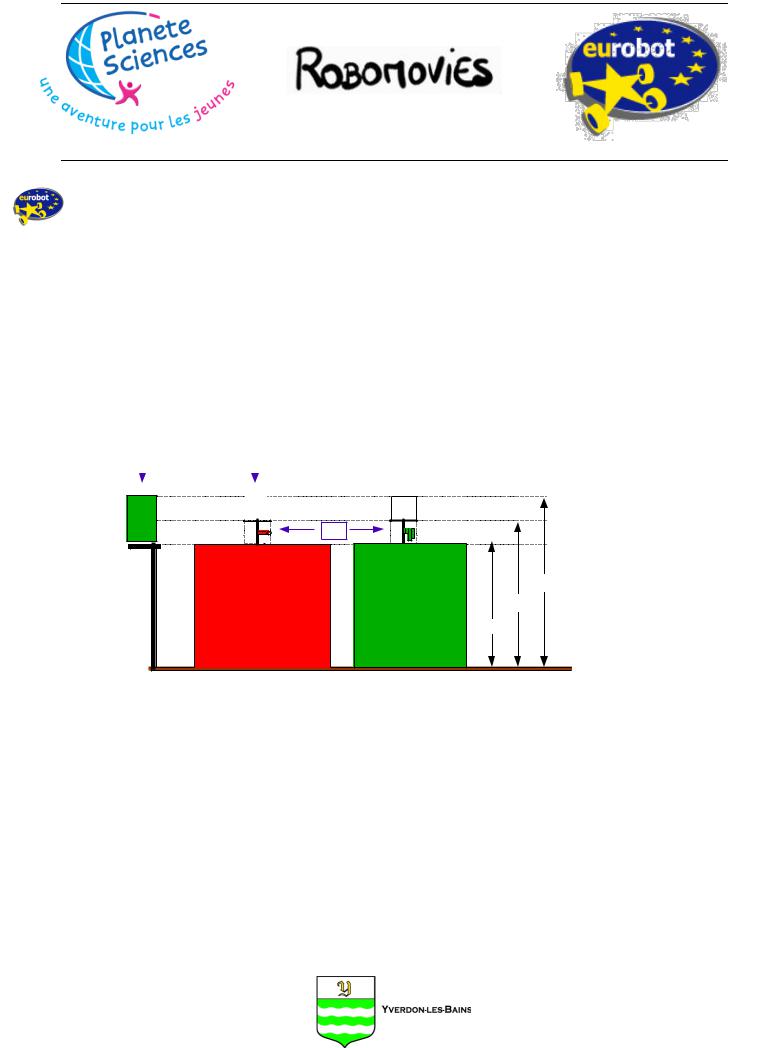
EUROBOT
Page 25
…Rules… Rules… Rules… Rules… Rules… Rules… Rules… Rules… Rules… Rules…
F.Beacon systems (specific EurobotOpen)
1.General points
Teams can use beacons around the playing area and on the opponent robot(s) to design a system for localization. The table provides three support platforms for each team to place beacons upon. These beacon supports are located on fixed positions as indicated by the figure below.
All beacons, i.e. those around the table and on the opponent robot(s) must have Velcro on the bottom side. It has to be the soft (“loops”) side of the Velcro. Beacons need to remain on their supports for the entire match.
All points regarding the safety of robots also apply to the beacons.
1 |
|
2 |
|
|
||
|
|
|
|
|
|
|
|
|
|
|
|
|
|
|
|
|
|
|
|
|
|
|
|
|
|
|
|
|
|
|
|
|
|
|
3
510 mm |
430 mm |
350 mm |
Legend:
Fixed beacon (maximum size: L x W x H: 80 x 80 x 160 mm)
Opponent beacon (maximum size: L x W x H: 80 x 80 x 80 mm)
Mast to support the platform. Sensors and electronics may be placed around the mast as long as they stay within the vertical projection of the platform
2.Opponent beacon
A beacon can be placed on top of each opponent robot. It can be used to localize the robot for the obstacle avoidance system.
This beacon must not exceed the size of a cube with 80 mm edges. In the spirit of fair play the beacons may only contain components that have a real use.
Additionally, opponent beacons also need to have Velcro on the topside. It has to be the rough
(“hook”) side. During the matches a tag indicating the team’s colour will be placed on top of it. A beacon must not exceed 400g.
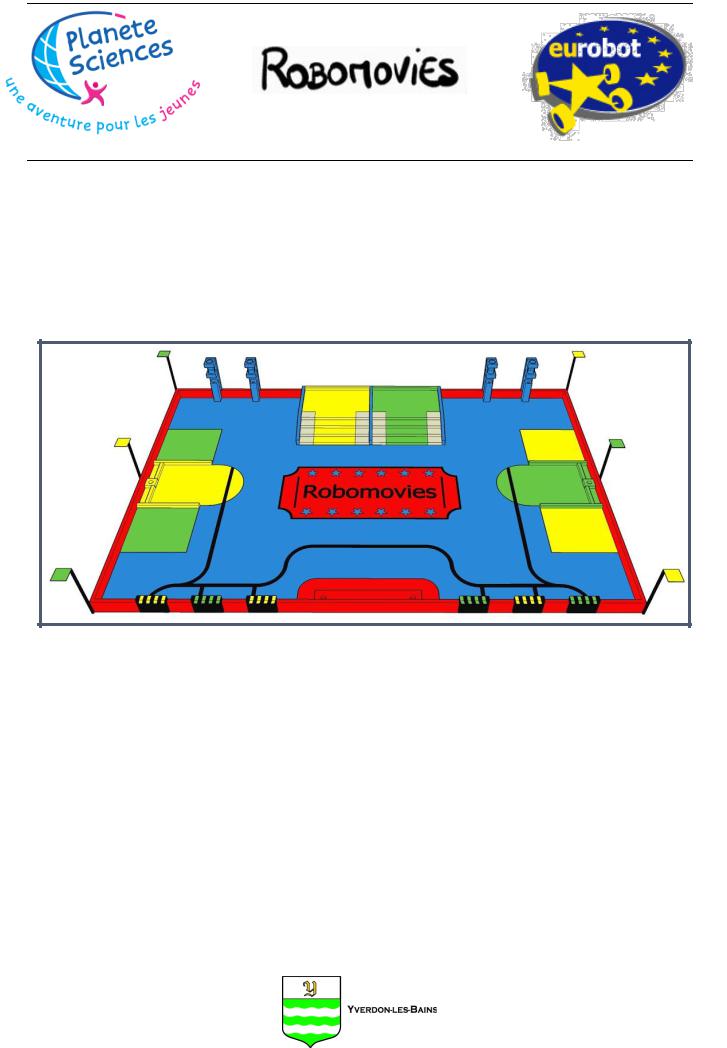
EUROBOT
Page 26
…Rules… Rules… Rules… Rules… Rules… Rules… Rules… Rules… Rules… Rules…
3.Fixed beacon
Each team can place three beacons on fixed locations around the table. Those locations are defined by the team’s colour in the match as indicated in the figure below. The dimensions of the beacons must not exceed a cuboid with a base of 80 x 80 mm and 160 mm height.
The fixed beacons can be connected to each other using a wire. This wire must not disturb the match in any case.
The setup of the whole system must be possible during the 3 minutes preparation phase prior to the match and must not disturb the opponent team.
Figure 26: Location of the fixed beacons and their assignment to the teams
4.Communication signals
It is recommended to encode all communications to avoid interferences between the signals of different teams.
The organizers use high-frequency radio devices and cannot be held responsible for any interference with a robot caused by them.
Special attention should be paid to the strong ambient light during the event, especially when using infrared or other optical devices. Furthermore, this light may vary between different tables and also even during a single match.
5.Identification tag
Tags are assigned to the robots in each match. These tags have a negligible weight and are placed on top of the opponent beacon or beacon support if there is no beacon.
The tags have the colour of the team and allow the audience to assign the robots to the teams.

EUROBOT
Page 27
…Rules… Rules… Rules… Rules… Rules… Rules… Rules… Rules… Rules… Rules…
G.Match procedure
The matches have a duration of 90 seconds.
Only two members of each team are allowed to access the stage and the backstage area.
1.The preparation phase
At first the playing elements are put in place according to the figures in the appendix.
When arriving at the playing table, the teams have 3 minutes to set up their robots and beacons.
Failing to meet this deadline may result in the team’s disqualification (scratch) from that match. In that case the opponent will play the match alone.
If both teams completed the setup, the referees ask if the teams are ready for the match. From this moment on it is forbidden to touch their robots or beacons (except the starting cord) ! No objection regarding the playing elements or their placement will be accepted from this point on.
2.The match
The referees will give the signal to start the robots after a short countdown. It is forbidden to touch the robots, the beacons, the table and its elements unless it is explicitly authorized by a referee. This also includes pressing the emergency button! Failing to comply with that rule may result in a team’s disqualification from that particular match (scratch).
Any elements leaving the table may not be returned.
After 90 seconds the robots must have stopped moving and switched off all actuators.
After the end of a match, no one except the referees is allowed to touch the robots or the playing elements. The referees count the points on a so called match sheet and explain them to the teams. (Please take a look at the next section on how to count points.) If both teams agree with the result, they sign the match sheet, take their robots and leave the stage.
If one team does not agree with the result of the match it may present its arguments calmly, while the robots stay in place. Please remember that only two members per team are allowed on stage. The decision of the referees is final.
In case of judging difficult situations, the referees can decide to replay or not the match.
If for example all robots are blocked, the referees may announce an early end of the match with both teams’ affirmation.
A scratch of a team happenned:
-when none of the robots of a team has completely left the starting area during the match
-when the emergency button has been pushed during the time of the match
-for other refereeing decisions.
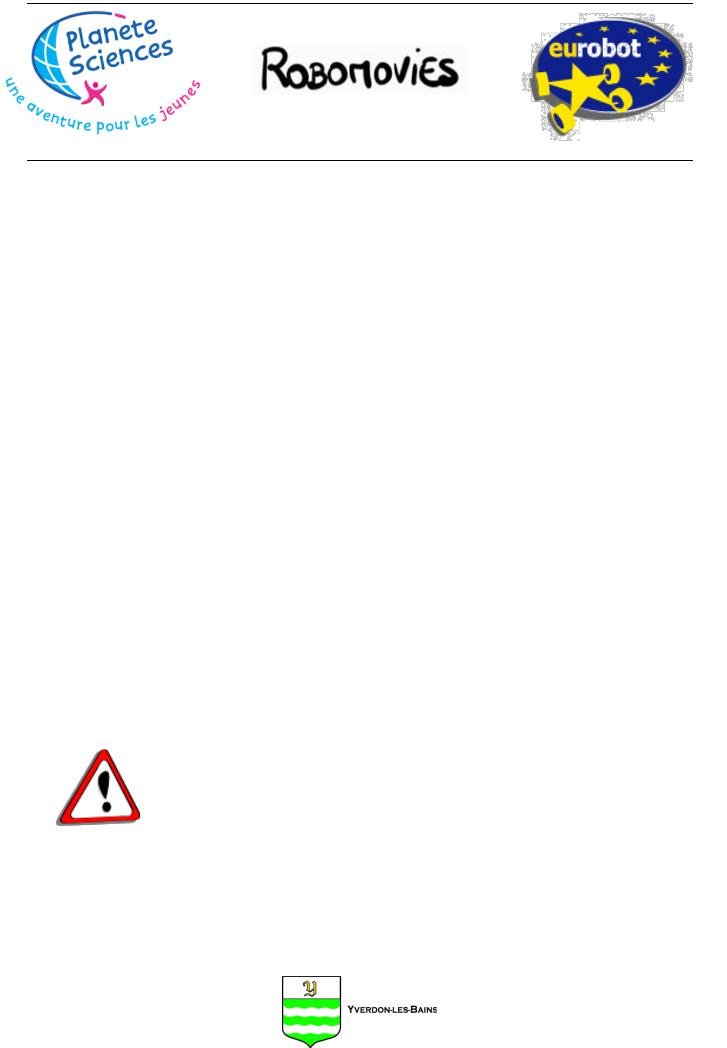
EUROBOT
Page 28
…Rules… Rules… Rules… Rules… Rules… Rules… Rules… Rules… Rules… Rules…
3.The scoring
The referees will count the points for each team as follows:
a. The spotlight
2 points for each valid stand.
3 bonus points for each valid stand placed in a spotlight.
b. The clapperboards
5 points for each closed clapperboard.
c. The popcorn
1 point for each popcorn located in a popcorn cup that is located in a cinema or located in a popcorn basket.
d. The red carpet
2 points for each step of a walkway covered partially or totally by a red carpet.
4 bonus points for each walkway whose steps have all been covered partially or totally by a red carpet.
e. Climbing the red carpet steps
15 points if at least one of the robot of the team is in contact only with the top of the steps.
Penalties
A penalty leads to a loss of 10 points for the match it occurred in.
A negative score will be rounded to 0.
An element controlled by a robot does not score any points. A playing element is considered to be in the control of a robot if by moving the robot along its innate axis of locomotion the element is also moved.
Bonus points: 5 bonus points is given to all teams that are not “scratched”, i.e. that have won or lost the match.
Reminder:
Penalties are intended to compensate for damages or disadvantages as a result of an incident during the match. A penalty situation is considered as a noncompliance with the rules and should remain the exception. A penalty may result in a scratch for the team. The referees will also pay attention to the cumulated penalties given during the qualification phases (regional, national and also
European).

EUROBOT
Page 29
…Rules… Rules… Rules… Rules… Rules… Rules… Rules… Rules… Rules… Rules…
H.The contests
1.Forewords
The EurobotOpen/EurobotOpen Junior events are organized on three levels:
In Regional events, where they exist (e.g. in France for EurobotOpen Junior), a certain number of teams can qualify for the national finals.
In |
National |
finals, |
four |
teams |
qualify |
for |
the |
European |
finals. |
Be aware that the number of team that can qualify has changed since last year! |
|
||||||||
In the European final the teams qualified by their national finals meet in the same friendly spirit.
2.Approval
Before a robot can participate in a match it needs to be approved by a referee:
In the pre-approval a referee verifies the robots’ compliance with the rules. Therefor the robot should be able to demonstrate all action it is capable of.
Approval: The robot(s) must demonstrate their ability to score at least one point under match conditions, i.e. in 90 seconds without the presence of an opponent team.
The avoidance system and other equipment will also be tested in that phase.
If the main robot and the secondary (optional) robot pass the tests, they are declared as approved. If only one out of two robots pass the approval this robot is can play the matches on its own.
Significant technical modifications after the approval: If significant changes are made to a robot, e.g. in its function, structure or dimensions, a referee needs to be informed. That referee will reapprove the robot and redo some test if it is considered necessary.
3.Qualification phases
Each team should have the possibility of playing at least three matches during the qualification phase. The local organizers can also decide to play more matches which are normally organized in rounds. To choose the teams for the finals, a ranking is set up by using the accumulated points of each team during the qualification phase.
If two or more teams have the same number of points, the teams will be ranked by comparing their scores without considering the bonus points.
If teams still level, the referees may decide to organize extra matches. In that case, pairs of teams competing for the same ranking will be drawn by lot and the winner of the resulting matches will move on to the final round.
In the case of an odd number of teams, an opponent for the last team is drawn by lots. Points scored by the randomly chosen team will enter the ranking.
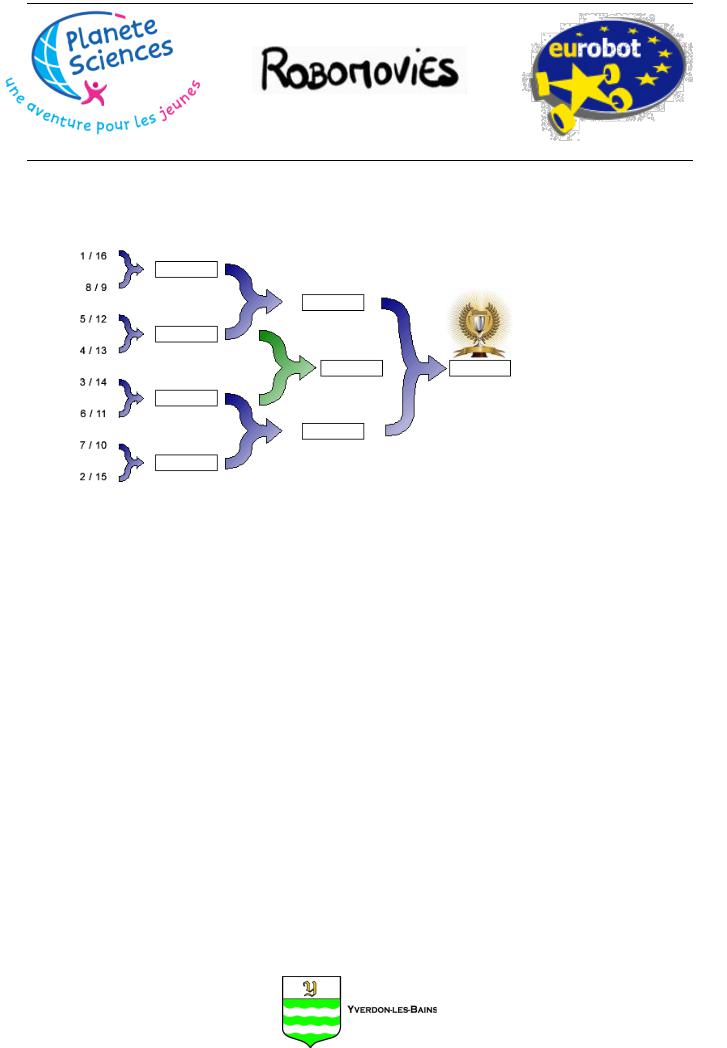
EUROBOT
Page 30
…Rules… Rules… Rules… Rules… Rules… Rules… Rules… Rules… Rules… Rules…
4.The finals
After the qualification phase, the first 8 or 16 teams (depending on the number of approved teams) will participate to the final phase according to the following figure:
Figure 27: Schematic of the finals
In this phase the matches are played as knock-out matches, i.e. the winner moves on to the next round. If a winner cannot be determined (double scratch or draw) the match is replayed immediately. If the situation is still unresolved, the points during the qualification can be taken as a criterion to declare the winner.
The final match for the first place is played as “best of three”. The team that first wins two matches wins the match.
5.Qualification for the national finals
Where the regional competitions exist (e.g. in EurobotOpen Junior in France) the number of teams that can qualify for the national competition is proportional to the total number of teams on national level.
The results of the qualification rounds are used to select the teams for the national finals.
Final rounds can still be hold to define the regional champion, but this champion is not necessarily qualified for the national competition!
At least one team received as special award (for example for creativity, fair play, best presentation, ...) and is also qualified for the national competition.
6.Qualification for the European finals
Each country participating in EurobotOpen and/or EurobotOpen Junior organizes a national competition to determine the teams qualified for the international phase. The top teams in the final rounds (not the qualification rounds) as well as the team who received a special award will qualify for the European finals.
